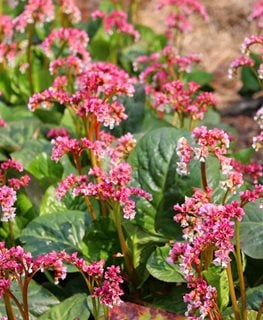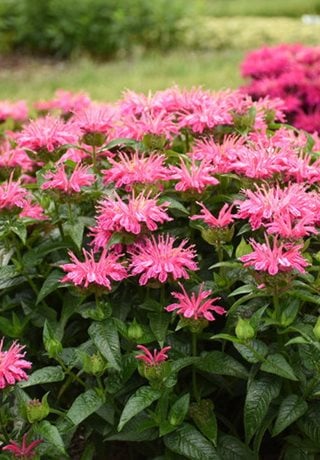How to Grow Beautiful Bergenia
Get planting and care tips for growing this spring-blooming, shade-tolerant ground cover.Are you in need of a low-maintenance ground cover that remains attractive in all seasons and will grow almost anywhere, from shade to full sun? Then look no further than Bergenia, also known as “pigsqueak” because of the sound made when you rub the leaves. Valued for both its flowers and foliage, Bergenia welcomes spring with showy panicles of dainty pink blossoms perched atop thick, upright stems. But its most remarkable feature are the big, glossy green leaves, which turn a gorgeous reddish-bronze in fall and remain colorful well into winter.
Low-growing and clump-forming, bergenia is most effective when planted en masse to carpet woodland and shade gardens or to edge pathways and borders. However, it also makes a stunning specimen or container plant thanks to its bold, eye-catching foliage.
On this page: Basics | Planting | Care | Varieties | Design Ideas
- BASICS
- HOW TO PLANT BERGENIA
- BERGENIA PLANT CARE
- BERGENIA VARIETIES
- DESIGN IDEAS FOR USING BERGENIA PLANTS
BASICS
Botanical name:
Bergenia spp. and hybrids
Note: Two bergenia species, B. cordifolia and B. crassifolia, are now considered to be synonymous and the names are often used interchangeably.
Common names:
Heartleaf bergenia, pigsqueak, elephant’s ears
Plant type:
Herbaceous perennial
Origin:
Native to central and eastern Asia
Zones:
Typically 4-8,with some hardy to zone 3
Exposure:
Part sun to full shade
Height/spread:
1 to 2 feet tall (when in bloom) and 1 to 3 feet wide
Bloom time:
Early to mid-spring, with the flowers lasting 3 weeks or longer. May bloom earlier in climates with warm winters.
Foliage:
Rounded or heart-shaped leathery green leaves grow up to 8 inches wide and have slightly toothed edges. In fall, the leaves turn rich shades of red, plum, or bronze. Foliage will remain evergreen in zones 6 and warmer.
Flowers:
Clusters of small, five-petaled flowers most commonly bloom in shades of pink, but may also be red, purple or white, depending on the variety. Some cultivars have semi-double blooms.
Special attributes:
- Deer and rabbit resistant
- Attracts bees and butterflies
- Few pest or disease problems
- Dense foliage growth suppresses weeds
Is bergenia invasive?
Although bergenia is a non-native plant that spreads via rhizomes, it is not considered to be invasive.
Is bergenia poisonous?
No. According to the ASPCA database of poisonous plants, bergenia is not toxic to cats, dogs, or horses. For more safe plant choices, see 20 Common Plants Safe for Cats & Dogs.
PLANTING BERGENIA
When to plant:
In spring, after the threat of frost has passed, or in early fall in frost-free climates.
Where to plant:
Bergenia will thrive in almost any amount of sunlight, but a site that receives light to moderate shade is ideal. In southern regions, protect plants from scorching afternoon sun.
How to plant:
Dig a hole about twice as wide and the same depth as the root ball and mix in any amendments, as needed. Place the plant in the hole so the crown is level with the surrounding soil and then backfill. Tamp the soil down gently, and water thoroughly to remove air pockets.
Soil:
Prefers hummus-rich, moist, well-drained soil, but will also adapt to poor soils, including clay.
Spacing:
If growing bergenia en masse, space plants 1 to 3 feet apart, depending on their width at maturity.
Growing from seed:
You can also grow bergenia from seed, starting the seeds indoors 6 to 8 weeks before the last frost date. Because bergenia needs light to germinate, don’t cover the fine seed, just press it slightly into the soil surface. Germinate at room temperatures of 70° to 75°F in moist soil. Have patience, since germination can take 3 to 6 weeks. Learn more about growing plants from seed.
Growing in containers:
Because bergenias are attractive from spring through fall, they are wonderful container plants, either alone or as fillers in mixed container combinations. To accommodate the plant’s root system and broad leaves, choose a pot with a diameter of at least 12 inches and depth of 8 to 10 inches. Also make sure the pot has plenty of drainage holes to prevent the soil from getting soggy. Get more tips for growing plants in containers.
BERGENIA CARE
Watering:
Bergenia performs best in soil that is kept evenly moist, but will tolerate short periods of drought once established. Plants located in full sun will generally require more frequent watering than those grown in the shade. Be careful not to overwater. Root rot can occur if your plants are allowed to sit in overly saturated soil.
Amendments and fertilizer:
Bergenia plants do not need supplemental fertilizer to thrive, especially when grown in nutrient-rich soil amended with organic matter. If you live in a hot, dry climate, put several inches of mulch around the root zone to help keep the soil moist, leaving the crown of the plant uncovered to avoid crown rot.
Pruning and deadheading:
In early spring, trim away any leaves that have become torn and tattered over winter to make way for fresh, new foliage growth. After plants flower, deadhead to remove the spent blooms and their stalks. This will make your bergenias look tidier and may prompt new flowers to emerge later in the season.
Dividing:
To keep plants looking their best, you should divide them every few years, or when they start to die out in the middle. This should be done in spring (after flowering) or in early fall. Dig up the whole clump, discard the woody center, and use a sharp garden knife to cut the remaining rhizomes into large sections, making sure each one has several leaves attached.
Overwintering:
Bergenia is very cold hardy, but there are measures you can take to minimize damage to your plants in areas with harsh winters. To keep strong, cold winds from tearing and desiccating the evergreen leaves, grow your plants in a protected location. Also apply a layer of mulch, such as straw, leaves, or other organic matter, in late fall to help protect your plants from frost damage and temperature extremes.
Pests and diseases:
Bergenia is seldom affected by insects, diseases, and animal pests, including deer and rabbits. However, black vine weevils and leaf spotting (a fungal disease) may occasionally become problems.
BERGENIA VARIETIES
DESIGN IDEAS FOR USING BERGENIA PLANTS
Although most often used as a durable, evergreen ground cover, bergenia can serve a variety of purposes in the landscape. Here are some ideas for taking advantage of its best attributes:
- For a spectacular floral display in late winter and early spring, combine bergenia with other early bloomers such as hellebores, winter aconite (Eranthis hyemalis), crocuses, and snowdrops.
- To bring big-leaf boldness to a shade garden, use in combination with or as an evergreen alternative for hostas.
- Plant in a rock garden or on a stony slope. In their native habitat, bergenias often grow and thrive in shaded, rocky locations.
- For interesting contrast, pair bergenia’s thick, fleshy leaves with columbines, ferns, bleeding hearts, and other shade-tolerant plants that have feathery, fine-textured foliage.
- Include bergenia in a cutting garden. The spiky flowers and glossy, heart-shaped leaves are real standouts in floral arrangements.















